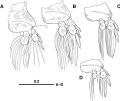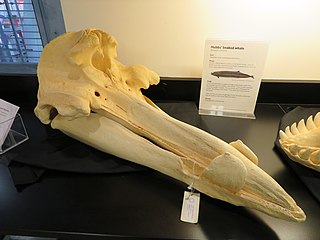
Hubbs' beaked whale was initially thought to be an Andrews' beaked whale when discovered by ichthyologist Carl Hubbs; however, it was named in his honor when it was discovered to be a new species. This species has the typical dentition found in the genus, but its main outstanding features are a white "cap" on the head and very extensive scarring. The species is known from 31 strandings, a few at-sea sightings, and observations of two stranded whales that were kept in captivity for 16-25 days.

Stomiiformes is an order of deep-sea ray-finned fishes of very diverse morphology. It includes, for example, dragonfishes, lightfishes, loosejaws, marine hatchetfishes and viperfishes. The order contains 4 families with more than 50 genera and at least 410 species. As usual for deep-sea fishes, there are few common names for species of the order, but the Stomiiformes as a whole are often called dragonfishes and allies or simply stomiiforms.

The Pacific viperfish, Chauliodus macouni, is a predatory deep-sea fish found in the North Pacific. It is reported as being either mesopelagic or bathypelagic, with diel vertical migration to shallower waters. The Pacific viperfish is one of the nine different species that belong to the genus Chauliodus, the viperfish. The Pacific viperfish tend to be the largest of the species, typically reaching lengths of up to 1 foot and are considered an example of deep-sea gigantism. The length-weight relationship of the pacific viperfish varies with sex with females tending to be longer and heavier than males.

Siphonostomatoida is an order of copepods, containing around 75% of all the copepods that parasitise fishes. Their success has been linked to their possession of siphon-like mandibles and of a "frontal filament" to aid attachment to their hosts. Most are marine, but a few live in fresh water. There are 40 recognised families:

Weevers are nine extant species of fishes of family Trachinidae, order Trachiniformes, part of the Percomorpha clade. They are long, mainly brown in color, and have venomous spines on their first dorsal fin and gills. During the day, weevers bury themselves in sand, just showing their eyes, and snatch prey as it comes past, which consists of shrimp and small fish.

A viperfish is any species of marine fish in the genus Chauliodus. Viperfishes are mostly found in the mesopelagic zone and are characterized by long, needle-like teeth and hinged lower jaws. A typical viperfish grows to lengths of 30 cm (12 in). Viperfishes undergo diel vertical migration and are found all around the world in tropical and temperate oceans. Viperfishes possess photophores along the ventral side of their body, likely used to camouflage them by blending in with the less than 1% of light that reaches to below 200 meters depth.
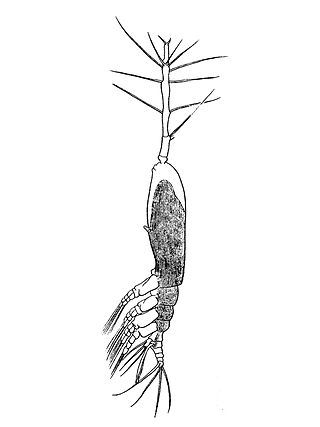
Monstrilloida is an order of copepods with a cosmopolitan distribution in the world's oceans. The order contains a single family, Monstrillidae. The name of the first ever described genus Monstrilla is derived from latin, meaning "tiny monster", because the lack of usual diagnostic features of copepods puzzled early taxonomists.

Chauliodus danae, or dana viperfish, is a species of viperfish in the family Stomiidae. The Dana Viperfish is mostly found in the bathyal zone. The species was first caught and recognised on the Dana expeditions 1920-1922 and named after the research vessel Dana.
Chauliodus vasnetzovi is a species of viperfish in the family Stomiidae, first discovered in 1972. It is generally found in the Bathypelagic zone in the Southeast Pacific near Chile and can grow to be up to 32.5 centimetres (12.8 in) long.
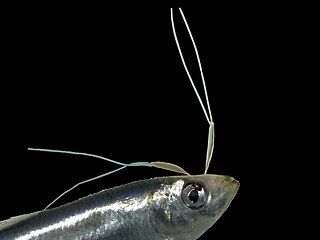
Pennellidae is a family of parasitic copepods. When anchored on a host, they have a portion of the body on the outside of the host, whereas the remaining anterior part of the parasite is hidden inside tissues of the host.
Pennella balaenopterae is a large ectoparasitic copepod specialising in parasitising marine mammals. It is the largest member of the genus Pennella, the other species of which are parasites of larger marine fish.

Sebastes schlegelii, also known as the Korean rockfish, Northern black seaperch, and Black rockfish, is a predatory species of marine ray-finned fish belonging to the subfamily Sebastinae, the rockfishes, part of the family Scorpaenidae It is found in the Northwest Pacific Ocean.
Chauliodus testa is an extinct viperfish in the family Stomiidae from the marine Late Miocene-aged Kurasi Formation of Western Sakhalin Island.
Peniculisa is a genus of marine parasitic copepods in the family Pennellidae.
Cardiodectes is a genus of copepods in the family Pennellidae. Species are parasites of fish.

Peniculus is a genus of marine copepods in the family Pennellidae. They occur worldwide and typically parasitize coastal or epipelagic fish, with the exception of Peniculus hokutoae that was found parasitizing a mesopelagic myctophid, Symbolophorus evermanni.
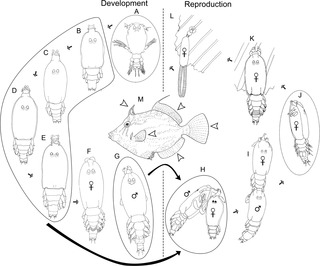
Peniculus minuticaudae is a species of parasitic pennellid copepod. It is known from the northeast Pacific Ocean. It was originally described in 1956, redescribed in 2012, and its complete life cycle has been elucidated on the cultured threadsail filefish, Stephanolepis cirrhifer in 2013.

Peniculus hokutoae is a species of parasitic pennellid copepod. It was described in 2018 from a single female. The type-host is the myctophid fish Symbolophorus evermanni and the type-locality is off Japan. The Japanese name of this species is hokuto-kozutsu-hijikimushi.

Symbolophorus evermanni is a species of fish in the family Myctophidae. It is widely distributed in the Indian and Pacific Oceans. The specific name evermanni honors ichthyologist Barton Warren Evermann. It is also known as Evermann's lanternfish or Evermann's lantern fish.



